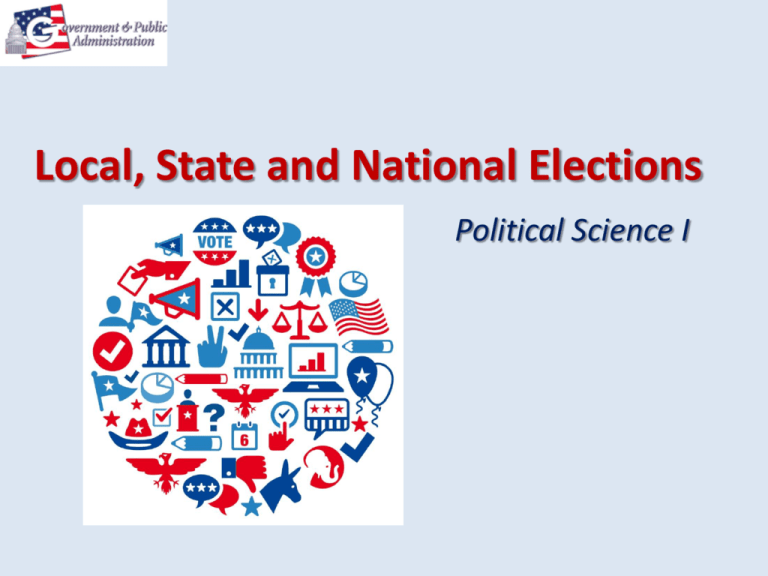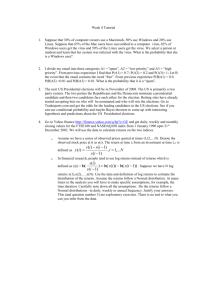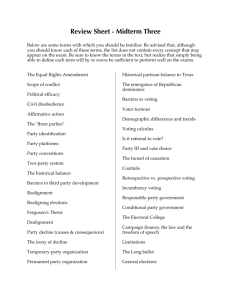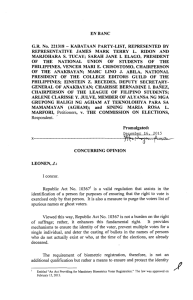
Local, State and National Elections
Political Science I
Copyright and Terms of Service
Copyright © Texas Education Agency, 2014. These materials are copyrighted © and trademarked
™ as the property of the Texas Education Agency (TEA) and may not be reproduced without the
express written permission of TEA, except under the following conditions:
1) Texas public school districts, charter schools, and Education Service Centers may reproduce
and use copies of the Materials and Related Materials for the districts’ and schools’
educational use without obtaining permission from TEA.
2) Residents of the state of Texas may reproduce and use copies of the Materials and Related
Materials for individual personal use only, without obtaining written permission of TEA.
3) Any portion reproduced must be reproduced in its entirety and remain unedited, unaltered
and unchanged in any way.
4) No monetary charge can be made for the reproduced materials or any document containing
them; however, a reasonable charge to cover only the cost of reproduction and distribution
may be charged.
Private entities or persons located in Texas that are not Texas public school districts, Texas
Education Service Centers, or Texas charter schools or any entity, whether public or private,
educational or non-educational, located outside the state of Texas MUST obtain written approval
from TEA and will be required to enter into a license agreement that may involve the payment of
a licensing fee or a royalty.
Contact TEA Copyrights with any questions you may have.
Copyright © Texas Education Agency 2014. All rights reserved.
Images and other multimedia content used with permission.
2
How do elections operate at the
local level?
Copyright © Texas Education Agency 2014. All rights reserved.
Images and other multimedia content used with permission.
3
Nonpartisan Elections
• Most elections at the local level are considered
non-partisan
• Candidates who are running for a position at the
local level do not declare a political party
• Party identification of certain candidates might be
known, but party labels are not used in most local
elections
• Some of the most important local elections include
elections for the Mayor, City-Council,
Commissioners, and School Board
Copyright © Texas Education Agency 2014. All rights reserved.
Images and other multimedia content used with permission.
4
Nonpartisan Elections (continued)
• Local elections occur in two forms
• District-based elections: candidates run for an
office that represents only the voters of a specific
district within the jurisdiction
• At-large elections: candidates for office must
compete throughout the jurisdiction as a whole
Copyright © Texas Education Agency 2014. All rights reserved.
Images and other multimedia content used with permission.
5
Nonpartisan Elections (continued)
• Issues with district-based and at-large elections
• At-large elections may keep minority representatives
from being elected
• District-based elections can also be racially or
ethnically biased in local elections by the drawing of
boundaries
• In some cases, local governments draw districts that
divide ethnic neighborhoods in order to give minority
groups a disadvantage in local elections
• A way to correct racial or ethnic bias in district-based
elections is to draw districts in a manner that makes
racial/ethnic groups a majority in a particular district
Copyright © Texas Education Agency 2014. All rights reserved.
Images and other multimedia content used with permission.
6
Types of Local Elections:
Mayoral Elections
• Local residents elect a mayor as well as the city
council members
• The Mayor is the head of city government
• There are two types of mayoral systems in the US
• Strong-mayor cities
• The city council makes public policy and the policy is
implemented by the Mayor (e.g. New York City)
• Weak-mayor cities
• The city council directs the activities of the city and the
mayor acts as the presiding officer for the city council (e.g.
San Diego)
Copyright © Texas Education Agency 2014. All rights reserved.
Images and other multimedia content used with permission.
7
Types of Local Elections:
Mayoral Elections (continued)
• The mayor is elected in a non-partisan election, and, in
most cities, the candidate must receive a majority of the
votes in order to become elected mayor
• This is considered to be an at-large election because it
is eligible to voters from every district within the city
limits
• For example, the mayor of the city of Dallas is voted on by
voters from Dallas, Rockwall, Kaufman, Collin, and
Denton Counties
• In most cases, mayors are elected to four-year terms
and do not have any term limits
Copyright © Texas Education Agency 2014. All rights reserved.
Images and other multimedia content used with permission.
8
Types of Local Elections:
City Council Elections
• The members of a city council are voted on by citizens of
that particular city
• City council members represent a district or a ward of the
city
• City councils were extremely influential during the era of
political machines
• City councils currently set policy for the city
• City councils during the era of political machines were very
segregated because party bosses urged council members to
create policy that would help individual districts/wards
rather than the city as a whole
• Therefore, many cities reverted to at-large elections so that they
would begin to benefit the city rather than the districts
Copyright © Texas Education Agency 2014. All rights reserved.
Images and other multimedia content used with permission.
9
Types of Local Elections:
City Council Elections (continued)
• Many large cities use district-based elections,
and smaller cites typically use at-large
elections
• Cities that use district-based elections most likely
have a large minority population and want to
ensure that they are represented equally on the city
council
• New York, Dallas, and Los Angeles have district-based
elections
• Seattle is one of the largest cities to have at-large city
council elections
Copyright © Texas Education Agency 2014. All rights reserved.
Images and other multimedia content used with permission.
10
Types of Local Elections:
Commissioner Elections
• The commissioner form of government consists of
three to nine members who have both legislative and
executive powers
• These public officials make public policy, just as the
officials in the others forms of city government
• Commissioner elections are at-large elections elected
on a nonpartisan ballot
• The commissioners are individually responsible for
passing ordinances and controlling spending
• Each commissioner is also elected as a commissioner of
a functional area of city government
• Examples include: public safety, parks, police, fire, etc.
Copyright © Texas Education Agency 2014. All rights reserved.
Images and other multimedia content used with permission.
11
Types of Local Elections:
School Board Elections
• Independent school districts are run as independent local
governments
• School districts are responsible for educating children within
their district
• In a school-district election, voters within geographically
defined areas are responsible for electing a board of
education
• This means that school-board elections are considered districtbased elections
• Although states are ultimately responsible for education,
such as mandating standards, local governments and the
school board deliver education services to the students
Copyright © Texas Education Agency 2014. All rights reserved.
Images and other multimedia content used with permission.
12
Types of Local Elections:
School Board Elections (continued)
• The school board is responsible for
building/operating schools, running education
programs, and raising revenues for schools
• Most of these decisions are also voted on by the
district voters
• Voters can authorize the school board to pass a
bond for school building, or they can authorize the
local government to increase taxes for raising
teacher salaries
Copyright © Texas Education Agency 2014. All rights reserved.
Images and other multimedia content used with permission.
13
Local Elections
• Although they have the lowest voter turnout
compared to state and national elections, local
elections can affect citizens more directly
Copyright © Texas Education Agency 2014. All rights reserved.
Images and other multimedia content used with permission.
14
How do elections operate at the
state level?
Copyright © Texas Education Agency 2014. All rights reserved.
Images and other multimedia content used with permission.
15
Partisan Elections
• Power of state elections
• At the state level voters usually have far more
power to determine who governs them
• Most top-level state policymakers are elected to
office by voters
• Top level policymakers include governor, treasurer, and
lieutenant governor
• Voters in some states are authorized to make law
directly through the ballot
Copyright © Texas Education Agency 2014. All rights reserved.
Images and other multimedia content used with permission.
16
Partisan Elections (continued)
• State elections historically have reflected the
general political mood of the country
• State elections do differ from national elections in the
sense that state executives are elected directly
• In national elections, the executive is elected by the
Electoral College and the Judiciary is appointed by the
executive
• State elections also tend to represent accurately
the ideology and demographics of their states
• State elections are also a good indicator of how the
states vote in national elections
Copyright © Texas Education Agency 2014. All rights reserved.
Images and other multimedia content used with permission.
17
Types of State Elections:
Gubernatorial Elections
• Gubernatorial elections have become more focused on the
individual candidate and less focused on party affiliations
• In most states, gubernatorial elections occur every four
years
• Gubernatorial elections have become high profile and many
gubernatorial candidates have to rely heavily on television
to reach voters
• Gubernatorial campaigns often hire national political
advisors to develop ad campaigns
• Campaigns can be extremely expensive, so candidates rely
on fundraising and funding from state political parties
Copyright © Texas Education Agency 2014. All rights reserved.
Images and other multimedia content used with permission.
18
Types of State Elections:
State Legislative Elections
• State legislative elections are very similar to
national congressional elections; however, they
typically represent a much smaller portion of
the population
• State legislators in most states are up for reelection every two years
• State congressional districts are also redrawn
when the US Congressional districts are
redrawn, every 10 years
Copyright © Texas Education Agency 2014. All rights reserved.
Images and other multimedia content used with permission.
19
How do elections operate at the
national level?
Copyright © Texas Education Agency 2014. All rights reserved.
Images and other multimedia content used with permission.
20
Presidential Elections:
The Nomination Process
• No US election compares to the presidential election
that occurs every four years
• This election is for the highest ranking political position in
the US
• Before a candidate can be chosen to participate in the
presidential election, he or she must be selected by the
delegates of the party’s national convention
• Delegates usually vote based on the results of the primaries
and caucuses in their states
• Primaries and caucuses usually begin in February of the
presidential election year
Copyright © Texas Education Agency 2014. All rights reserved.
Images and other multimedia content used with permission.
21
Presidential Elections:
The Nomination Process (continued)
• The role of the primaries and the caucuses in
the presidential election has been altered by
front-loading
• Front-loading: the tendency of states to choose an
early date on the nomination calendar in order to
make their state more important during the
nomination process
• Currently the first caucus in the US is in Iowa and
the first primary is in New Hampshire
Copyright © Texas Education Agency 2014. All rights reserved.
Images and other multimedia content used with permission.
22
Presidential Elections:
The Nomination Process (continued)
• The conclusion of the primary and caucus
elections usually occurs in June; however, the
presidential nominee for the party is usually
determined after “Super Tuesday”
• Super Tuesday: the day in March when several
states hold their primaries/caucuses and the day
that the highest amount of delegates are at stake
Copyright © Texas Education Agency 2014. All rights reserved.
Images and other multimedia content used with permission.
23
Presidential Elections:
The National Convention
• Every year each party holds a national convention to
nominate its presidential and vice presidential candidate
• Delegates are elected to attend the conventions for each
party, and they are supposed to represent the demographic
makeup of the American population
• The number of delegates are different from the Republican
and Democratic conventions because Democrats allow for
“superdelegates”
• Delegates usually vote for the presidential candidate who
won their state’s primary or caucus
• Each party is responsible for conducting state primaries and
caucuses, and for electing their candidates for the
Presidential election
Copyright © Texas Education Agency 2014. All rights reserved.
Images and other multimedia content used with permission.
24
Congressional Elections
• House of Representatives
• Each state elects members to the national House of
Representatives
• The number of representatives per state is based
upon a state’s population
• Members in the House of Representatives are
elected to two-year terms and then must run for reelection
• There are no term limits for members in the House of
Representatives
Copyright © Texas Education Agency 2014. All rights reserved.
Images and other multimedia content used with permission.
25
Congressional Elections (continued)
• Senate
• Two senators per state are elected to make up the
100-member US Senate
• Senators are elected every six years and there are
no term limits on US Senators
Copyright © Texas Education Agency 2014. All rights reserved.
Images and other multimedia content used with permission.
26
Which officials are appointed in
the US?
Copyright © Texas Education Agency 2014. All rights reserved.
Images and other multimedia content used with permission.
27
The National Level
• National Supreme Court
• As part of the checks and balances principle in the US,
Supreme Court justices are appointed by the Executive
Branch (the President of the US)
• The Legislative Branch ratifies the appointment made by the
president
• Once appointed by the president and confirmed by
Congress, Supreme Court justices have life tenure
• The president can also appoint federal judges who serve over
cases in the federal district courts
• Supreme Court justices are the highest ranking in the
judicial system in the US
Copyright © Texas Education Agency 2014. All rights reserved.
Images and other multimedia content used with permission.
28
The National Level (continued)
• Presidential Cabinet
• Once elected to the Office of the President, the president is
responsible for selecting officials to the Presidential
Cabinet
• The Presidential Cabinet consists of 15 different
departments that are administered by cabinet members
called secretaries
• The only cabinet department that is not headed by a secretary is the
Department of Justice (DOJ)
• The DOJ is headed by the Attorney General
• Other appointed cabinet members include: US
Ambassadors, Ambassadors to the United Nations (UN),
and Head of the Environmental Protection Agency (EPA)
Copyright © Texas Education Agency 2014. All rights reserved.
Images and other multimedia content used with permission.
29
The National Level (continued)
• The fifteen major
cabinet departments
include
•
•
•
•
•
•
Agriculture
Commerce
Defense
Education
Energy
Health and Human
Services
• Homeland Security
• Housing and Urban
Development
• Interior
• Labor
• State
• Transportation
• Treasury
• Veterans Affairs
• Justice
Copyright © Texas Education Agency 2014. All rights reserved.
Images and other multimedia content used with permission.
30
The State Level
• Governor
• Governors often act as the president does when it
comes to official appointments
• Governors can appoint heads of departments, such as
education, treasury, etc.
• In seven states, the governor can appoint the attorney
general of the state (O’Conner, Sabato & Yanus, 2011,
p. 124)
• In three states (Hawaii, Maine, and New Jersey),
the governor is also allowed to select state supreme
court justices
Copyright © Texas Education Agency 2014. All rights reserved.
Images and other multimedia content used with permission.
31
The Local Level
• Mayors
• Mayors are often responsible for making
department appointments as well
• These departments include
•
•
•
•
Parks
Sanitation
Public Works
City Manager
Copyright © Texas Education Agency 2014. All rights reserved.
Images and other multimedia content used with permission.
32
Resources
•
•
•
•
•
•
•
Edwards, George, Martin Wattenberg, and Robert Lineberry. Government in
America: People, Politics and Policy. 15. New York City: Longman, 2011. Chapter
17 & 21. Print.
Harrison, Brigid, and Jean Harris. American Democracy Now. 2. New York City:
McGrawHill Company, 2011. Chapter 15 & 18. Print.
O'Conner, Karen, Larry Sabato, and Alixandra Yanus. American Government:
Roots and Reform. 2011. New York City: Longman, 2011. Chapter 4 & 18. Print.
Patterson, Thomas. The American Democracy. 9th. New York City: McGraw Hill
Higher Education, 2009. Ch. 15 & 18. Print.
Schmidt, Steffan, Mack Shelley, Barbara Bardes, and Lynne Ford. American
Government and Politics Today. 2011-2012. Boston: Wadsworth Cengage Learning,
2012. Chapter 17 &19. Print.
National Conference of State Legislatures (NCSL)
http://www.ncsl.org/research/about-state-legislatures/2010-constituents-per-statelegislative-district.aspx
https://www.whitehouse.gov/administration/cabinet
Copyright © Texas Education Agency 2014. All rights reserved.
Images and other multimedia content used with permission.
33









